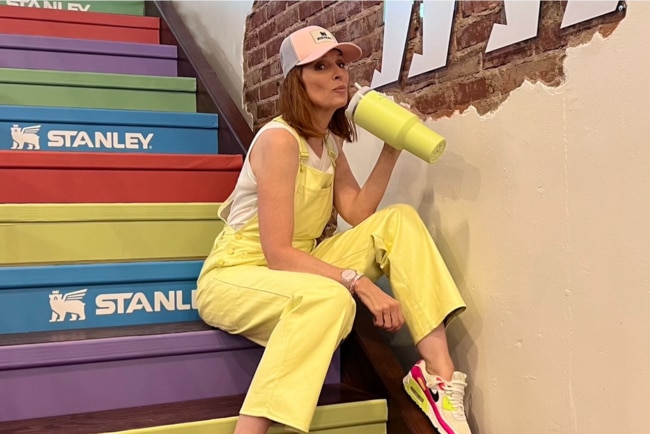Stanley looks to replicate the water-bottle hype among guys
The company wants to widen its consumer base and product lines after its blockbuster growth among women.

Stanley has spent the past few years turning a vacuum-insulated, 1.18 litre water bottle into one of the most-desired womenswear accessories on the planet. Now it is widening its focus to include the customer it was first designed for more than 110 years ago – men.
The company, which is owned by Chicago-based HAVI, next year plans to release new products geared toward guys beyond its current male audience of outdoor enthusiasts.
The new Stanley man might not require a steel canteen to take into the wilderness, but he might want a sleek water bottle to take from the office to the gym to date night in a wine bar, according to Jenn Reeves, Stanley’s vice president of global brand marketing.
“He’s not a fashionista, but he cares about how he’s put together. He’s into grooming and how he looks, and into sports,” Ms Reeves said. That hypothetical male customer wants water bottles that are a little sleeker and subtler than the brightly coloured giant flasks coveted by Stanley’s female audience, she said.
The bid for diversification comes as Stanley looks to hold on to the brand equity it has accrued in a remarkably short time.
Stanley’s annual revenue jumped to around $750m in 2023 from $73m in 2019, and scores of articles and think pieces have in the past year been written to explain how a company originally targeting construction workers became one of the trendiest brands of the moment. Much of the success comes down to the recent rise of the brand’s 1.18 litre Quencher, which it introduced in 2016. The $45 metal cup with a straw and a handle has become a status symbol among women and tweens, caused new-product frenzies in stores, and generated a “Saturday Night Live” skit lampooning women who drink out of comically “big dumb cups.” Imitators and competitors for thirsty consumers are hot on Stanley’s heels. They include cooler-maker Yeti, which last year introduced a 1.24 litre straw mug similar in design to the Quencher.
Stanley’s latest release is a collection of cooler bags and a carryall holder for its 1.18 litre Quencher bottle, slated for release in April. The wearable coolers were developed in response to women’s complaints that the market’s existing offerings were too heavy, too clunky and too ugly, and the crossbody was designed to ease the burden of carrying a water bottle and a purse around all day.
Beyond hammertone green The Stanley customer only became known internally as a “she” in 2020, when Terence Reilly, the former chief marketing officer of Crocs, joined as president.
Reilly, who liked to say his team had turned Crocs’ divisive shoes “from a meme to a dream,” learned that the Quencher was becoming popular among a group of women in Utah, a few of whom ran a shopping blog called the Buy Guide, according to one of the blog’s co-founders.
The group, along with a female Stanley sales account manager, suggested that the company start selling its cups in colours outside of black, white and its signature hammertone green, and it did. Sales lifted, while the company began to lean more on real women to spread the word about its products.
The Stanley marketing team has grown slowly since Reilly’s arrival but is still tiny by industry standards: only seven full-time staff members across advertising, brand, marketing, media and social media, said Reeves, who joined in 2022. The company spends money on traditional direct marketing, such as email campaigns, but its biggest focus is social media and working with real women and influencers who promote Stanley to their followers.
Stanley got a big, unexpected break in November, when a TikTok user named Danielle Lettering posted a video claiming that the only item to survive her car fire was her Stanley Quencher. The clip went viral, and Stanley bought her a new car and covered related costs including taxes.
Many of Stanley’s male consumers are already Quencher fans, Stanley said, and guys sometimes feature in its ads. The company heading into 2025 has to translate its social-media momentum among women into a marketing strategy designed to attract more men with the planned sleeker range.
The typical male consumer is also swayed by the recommendations of influencers, but he often spends time on different platforms than his female counterpart, said Chris Anthony, the chief revenue officer of media company Gallery Media Group, which works with social-media content creators. He is likely to track interests, teams and channels, as opposed to following specific influencers across all platforms the way some women do, he said.
“Guys rely more on their feed versus the people,” Mr Anthony said. “And letting the influencers tell their stories, and not being so prescriptive, will especially resonate with guys in the right way.” Some of those influencers might be Stanley’s current best customers, Ms Reeves said. “We have the women, and they love us,” she said.
The Wall Street Journal.


